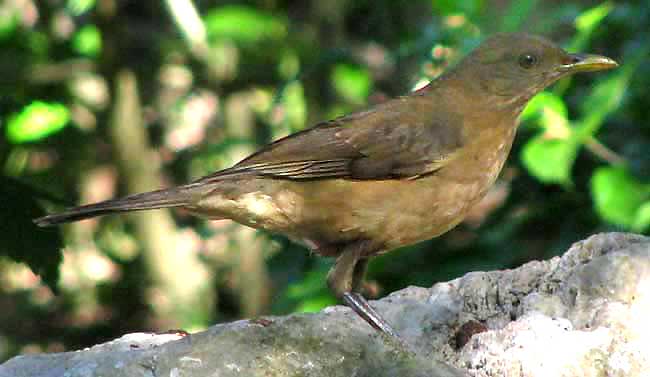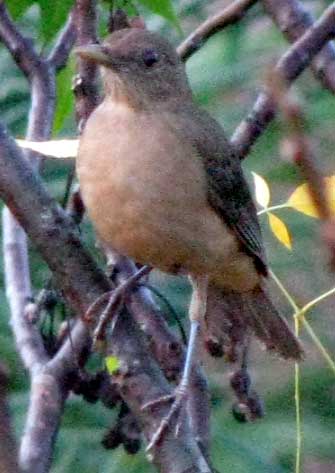Excerpts from Jim Conrad's
Naturalist Newsletter

from the January 17, 2010 Newsletter issued from Hacienda Chichen Resort beside Chichén Itzá Ruins, central Yucatán, MÉXICO
CLAY-COLORED ROBINS
When I arrived here two months ago the most abundant and frequently heard bird species was surely the Clay- colored Robin, TURDUS GRAYI, one shown on a wall above. Gradually the Clay-colored Robins have disappeared from around Hacienda Chichen until now they're fairly uncommon, though occasionally you do hear their slurred, catty reeeurrrs issued from shadows. The reason they were so numerous earlier is that back then the big strangler fig trees here were laden with marble-size, spherical figs, and of all the birds who ate their fill of those figs surely the Clay-colored Robins were the most enthusiastic. At 10 AM on a hot, sunny morning the big trees' limbs would be so robin- shaken that the trees seemed to shake with laughter. And if trees have some kind of self-awareness, maybe they were, just feeling themselves bubbling inside with such unbounded robin gratification.
North Americans with lawns on which American Robins hop around in the summer foraging for earthworms will see that Clay-colored Robins look just like American Robins, except that they're gray-brown. The size, form, behavior and many of the calls of the two species couldn't be more alike. They are both members of the genus Turdus.
Though Clay-colored Robins are common throughout eastern and southern Mexico, south to Colombia, Howell's A Guide to The Birds of Mexico and Northern Central America doesn't mention them. Rather, it lists the species as the Clay-colored Thrush. Howell is sensitive to the fact that English-speaking European colonizers coming into the New World were very sloppy with their plant and animal naming. To have named our American Robin after the much smaller, unrelated, and only vaguely similar European Robin was simply egregious. American birds are thrushes, not robins.
Still, after a lifetime of calling the American birds robins, it's hard to call them thrushes. I doubt that they'll ever change "American Robin" to "American Thrush," so why try to undo the Clay-colored Robin's name? Anyone really concerned with proper naming should use the technical name: Turdus grayi.
from the May 12, 2007 Newsletter issued from Sierra Gorda Biosphere Reserve,QUERÉTARO, MÉXICO
CLAY-COLORED ROBINS BUILDING NESTS
One of my favorite hiking destinations lies at the far end of the reservoir, about 45 minutes away, where the valley narrows, the lake becomes a trickling stream, and Bonpland Willows and Mexican Sycamores create a shadowy woods. Livestock trails paralleling the stream take me through the woods. Beneath every big tree there's always a comfortably rounded boulder you can sit on, and always the birds are putting on a show.
This week Clay-colored Robins have been particularly vocal and busy. They hop on the ground tossing litter aside with their bills just like American Robins. When worried about something they issue nasal clucks the way nervous American Robins do, and their body shape and size is just like the American Robin's. The only obvious big difference between the two species is that the Clay-colored's drab plumage shows only hues of brown. Below you can see one I photographed another time in the Yucatán.

This week I watched a Clay-colored Robin starting the building of her nest with what appeared to be dried-up willow rootlets left hanging on dry banks, now that the water is so low. I read that the finished nest will have a middle layer of mud. The species lays 2-3 pale to bright blue eggs, and may produce two broods. I also read that Clay-colored Robins eat earthworms, slugs, insects, fruits, and sometimes lizards. They follow army ants and feed on small animals trying to escape the ant columns.
Clay-colored Robins are so reminiscent of American Robins that I just assumed that, as with the American Robin, the Clay-colored male would claim and vigorously defend a territory, while the female nested somewhere within it. Therefore, this week, what I saw didn't make sense.
Around the tree where the female Clay-colored Robin was building her nest I saw three other Clay-colors doing various things. Moreover, as I continued up the valley I passed through several clusters of the species. I heard lots of singing and saw some courtship behavior but most robins seemed to be doing nothing special. In fact, what stuck me was that nowhere could I see territory-boundary disputes taking place, and clearly there were no territories being claimed by exclusively male-female family units. This was a situation to place before Google.
On the Internet I found no comprehensive description of Clay-colored Robin behavior, but I did find brief references and side remarks that gradually presented a picture.
In an online article of the journal The Condor,at https://www.jstor.org/stable/1370573?seq=1 I found the Clay-colored Robin's social system described as "mating aggregations, leks," and its territoriality as "short, local display court." In the same paper I read that Clay-colored Robins "display in groups."
That word "lek" refers to an aggregation of males, each seeking to attract a mate, and each displaying fervently. It's assumed that "lekking" groups attract more females than do isolated males, and probably this helps the females better compare their potential mate.
Another online article referred to Clay-colored Robins as "polygynous," and yet another called them a "potentially polygynous (lekking) species." In biology, polygyny is a mating practice in which the male takes more than one female sexual partner.
Digesting these laconic and somewhat cryptic lines gradually I conjured an idea of what I'd seen among the Clay-colored Robins that day.
I would guess that that morning the livestock trail along the stream took me through one "mating aggregation" after another, each group consisting of one to several females and a male, and maybe there were "surplus males" weaving in and out of groups as opportunities arose.
That's just a guess, though. The only thing for sure is that at first glance Clay-colored Robins may remind us a very great deal of American Robins, but by no means do their mating activities come close to how Northerners expect a good robin to behave.
from the February 26, 2012 Newsletter issued from Hacienda Chichen Resort beside Chichén Itzá Ruins, central Yucatán, MÉXICO
ROBINS STARTING TO SING
A few Clay-colored Robins began their first tentative calling in early mornings and late afternoons last week. This week more birds are doing it for longer periods each morning and late afternoon, but still it's nothing like what it soon will be. This week mostly I'm hearing their catlike mews, with only a few isolated echoic or chiming song-phrases.
from the May 9, 2010 Newsletter issued from Hacienda Chichen Resort beside Chichén Itzá Ruins, central Yucatán, MÉXICO
CLAY-COLORED ROBIN SINGING
Without a tripod, and pushing my little pole-steadied hand-held camera to 20X, I don't think I'll ever get videos that don't bob around. Still, I'll probably keep making them, if only to record the sounds. In this week's Clay-colored Robin video it's the song that's important.
For, each early morning and late afternoon the chorus of many Clay-colored Robins singing is simply majestic -- not only because of the sheer volume and number of birds involved, but also because this bird's song is particularly pleasing to hear, so varied, sometimes a little echoic, like distant bells. I hope the following video comes through for you:
from the May 30, 2010 Newsletter issued from Hacienda Chichen Resort beside Chichén Itzá Ruins, central Yucatán, MÉXICO
THE ROBINS' POP TUNE
From just before dawn to just after dusk the whole landscape still effervesces with the never-ending, melodious singing of Clay-colored Robins.
The video shown above was made here about a month ago. Approximately a week after that video was posted I began noticing a new phrase certain singing robins were inserting into their songs. It consisted of two notes similar in tone and quality to the monotonous series of one-note calls the Laughing Falcons were making at that time. There'd be the robin's continual, bubbly call of varied, sometimes echoic or bell-like phrases, then these two "falcon calls" would be inserted, and then the bubbly calls would continue.
Before long it seemed that every robin regularly and persistently inserted falcon calls into his singing, so that for a couple of weeks it was almost annoying hearing those distinctive sounds issuing from all directions, all the time. Then, suddenly, though the robins' calling continued unabated, the falcon sounds began dropping out. During this whole last week I've not heard a single falcon sound.
Though it's gross anthropomorphizing, one wants to guess that one day a robin hit upon the idea of inserting the falcon call, the other robins fancied the new sound and began doing the same, then they all passed through a period of obsessively calling it to one another -- like coast-to-coast teenagers who can't hear and sing enough the newest pop hit -- but then one day abruptly everyone has had enough, can't take it any more, and the once-craved sound just vanishes.
Moreover, this last week I think I've been hearing yet another sound in their calls I've not heard before, a funny-sounding "boing-boing" phrase, and at this writing that's starting to disappear, too, after a much shorter run on the robin hit-parade.
When I was a kid on the Kentucky farm back in 1964 I was a ham radio operator talking with people via shortwave all over the world, in Morse code (my call was WA4PGA). That spring a Mockingbird began calling in a Flowering Peach outside my upstairs window, and before long he was inserting brief phrases of Morse into his song -- clearly recognizable dots and dashes issued at the same pitch -- but of course he never did say much intelligible. That was close to what's been happening here, but that Mockingbird kept sending Morse each spring for two or three years. I've never heard of a call suddenly flashing " into vogue," then just as quickly totally disappearing. Have you?
from the July 25, 2010 Newsletter issued from Hacienda Chichen Resort beside Chichén Itzá Ruins, central Yucatán, MÉXICO
THE ROBINS FALL SILENT
I've mentioned how for months the Clay-colored Robins' pre-dawn to after-dusk, ever varying, sometimes echoic or chiming song-phrases filtered through my hut's pole walls, their notes mingling with music played on my computer, and with my own whistling. For months these songs created a shimmering musical ocean engulfing my hut-ship, texturing everything I did, thought and felt. Sometimes I've felt like an incidental little melody merely wandering through the monumental, effervescing rainbow of sound.
This week, the robins' nesting season over, the singing has ended. A few calls linger here and there, especially their special mewing at dusk, but there's no doubt that the grand performance is over. Melodious Blackbirds have become the most conspicuous callers with their liquid but relatively mechanical WHEE-choo, WHEE-choo, WHEE-choos, but, it's not the same.